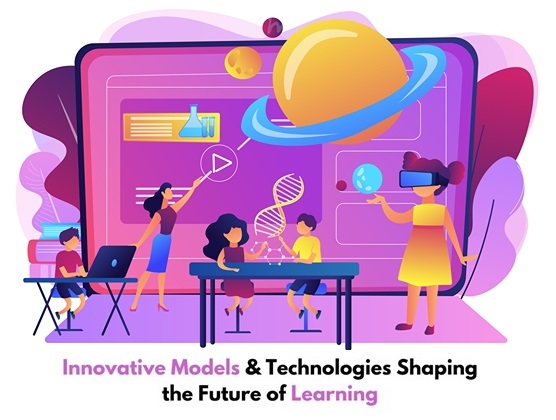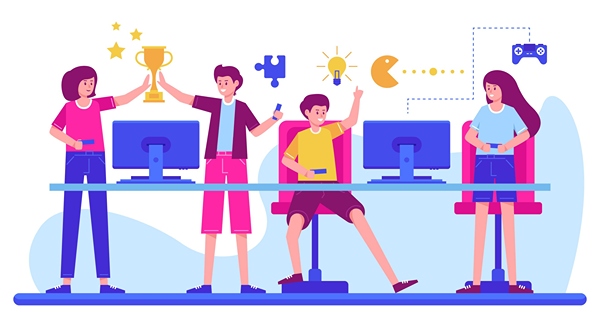Innovative Models & Technologies Shaping the Future of Learning
What will classrooms look like ten years from now? Shall students still sit in rows & listen to lectures, or will they wander through new worlds in virtual reality? Expect a world where learning isn’t about memorizing facts but magically experiencing knowledge. Sounds exciting, right?
Technology is progressing so fast & the field of learning is going to keep up with it. This means you can expect a bright future that’s full of advancements.
But how precisely is all this happening? What have been the key technologies & models behind this change? More importantly, how will these innovations influence our learning & teaching methods & progress?
Let’s dive into the heart of the future of learning & explore sophisticated technologies & innovative models that are geared toward reshaping education as we know it today.
Personalized Learning: Tailoring Education to Individual Needs

Image by vectorjuice on Freepik
Just imagine entering a classroom, & every lesson appears as though it was designed for you.
That is exactly what the power of personalized learning can offer. Unlike the one-size-fits-all, same-time lesson presentation in conventional learning, personalized learning works to adapt to the unique needs & interests of each learner.
Consider this example: Think of a student who might find it hard to understand mathematics. In the traditional setup, he will easily be left behind, losing the motivation to take part actively in learning.
On the other hand, in personalized learning, the AI system will spot areas where that student needs improvement & provide valuable resources & support to him.
It’s similar to a tutor who knows precisely what you need, exactly when you need it.
Personalized learning is not just for students who struggle with understanding some concepts. It also allows gifted students to work at a pace that moves them into more challenging materials & projects.
This practice ensures all learners are appropriately engaged, motivated, & working to the best of their abilities.
Gamification: Making Learning Fun & Engaging
Who says learning is boring?
Gamification—it is fun to learn!
Teachers make learning more engaging by incorporating the basic elements of games. The idea is to turn learning into a game so kids can enjoy learning.
Let’s say you are in a history class, & you get points for answering questions correctly. More points mean higher levels with new quests & prizes.
It’s a game!
Learning is not boring this way, & you are ready to learn more.
Gamification taps into that natural competitiveness & drive for achievement in everyone. Now, to learn is to play a game where each correct answer is a victory, & each lesson learned is an adventure.
Who wouldn’t want to learn like that?
Virtual Reality (VR) & Augmented Reality (AR): Bringing Lessons to Life
VR & AR are bringing lessons to life!
Do you want to see history happen right in front of your eyes? Or walk in the Amazon rainforest while sitting in your classroom?
Virtual & augmented realities make those dreams come true!
With VR, you feel as if you are inside the world of historical events.
AR, on the other hand, is like a magic window that lets you see digital information about the real world around you.
Amazing!
Imagine a biology class where the students can virtually take a 3D tour of the human body. You can easily zoom into the organs & systems to understand how they really work.
You are in a history class, & you walk through how Rome used to be many years ago. Seeing & hearing makes it more vivid than reading. These technologies make learning more fun, interactive, & memorable, thus enabling students to understand & remember things better.
The Evolution of OCR Technology
OCR (Optical Character Recognition) technology has been around for over a century. Originally, it was developed to help visually impaired students, educators, & people in general. Early on, OCR systems were limited by predefined rules. That’s why it was less effective in accurately recognizing different text formats.
As technology progressed and the internet emerged, OCR technology became more sophisticated. Today, educators and learners alike benefited greatly from the ability to scan and edit text from images, as well as physical documents, and convert them into editable, searchable digital formats. This is all thanks to online tools that are readably available to anyone with a computer.
Although OCR was long an unsung hero when considering the future of education, the evolution of OCR has recently accelerated, driven by breakthroughs in artificial intelligence. These advancements have transformed OCR from a rule-based system into a more flexible and intelligent technology capable of learning from vast datasets.
Thanks to AI & deep learning, modern OCR systems can now recognize text with remarkable accuracy, even in challenging conditions such as poor lighting, distorted images, or unusual fonts. They can also process multiple languages and scripts, making the technology more globally accessible.
Artificial Intelligence: The Future of Education
Artificial intelligence is no longer some hypothetical concept born out of the pages of science fiction. It is here, & with it are a million ways to change the way we approach education.
AI can be used to create intelligent tutoring systems, analyze piles of data from students, & even predict future learning outcomes.
Imagine an AI-driven tutoring system that could diagnose students’ strengths & weaknesses at any particular time. It provides feedback & guidance at a personal level. It’s almost like a personal tutor who knows precisely what is required for success.
AI is also used to analyze huge educational data volumes, helping educators understand what works & what doesn’t. That data-driven approach would ensure continuous improvement in teaching methods, ensuring each child’s best possible learning experience.
Conclusion
The future of learning is bright & filled with opportunities.
In fact, it’s shaped by innovative technologies & models that are revolutionizing the entire learning system. In that manner, personalized learning, gamification, AI, & OCR technologies are steadily bridging a more engaging, inclusive, & effective experience of learning in the classrooms.
Let’s embrace these new models & technologies, going into the future, with the determination to shape the future of learning, which will be innovative, compassionate, inclusive, & empowering.





